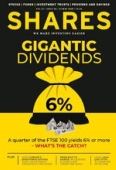Archived article
Please note that tax, investment, pension and ISA rules can change and the information and any views contained in this article may now be inaccurate.
Helping you find the best sources of income

Income is highly desired by investors but it not always easy to find sustainable dividends. This week’s edition of Shares dives into this theme and looks at income choices from the perspective of three different product classes: shares, exchange-traded funds and investment trusts.
We’ve analysed these products from different angles to help you get an edge when looking for income choices. In this week’s digital magazine you will find information on:
– Stocks offering above-average yields
– Ways to check if dividends are sustainable
– The different types of dividend-themed ETFs
Global dividends rose by 7.8% in the first quarter of 2019 to a record high of $263.3bn, according to research by asset manager Janus Henderson. And the UK market is currently yielding 4.7% which is significantly greater than interest available on cash savings, albeit with higher risk.
So what’s the catch? Many stocks and funds have generous yields because the value of their shares (or those in a fund’s underlying portfolio) has fallen on market concerns about their financial health and earnings growth. Concerns about those issues can act as warnings signs and potentially lead to dividend cuts down the line. Income-hungry investors will therefore need to wade through a lot of information before making investment decisions.
There are several checks you can make to see if companies can afford to pay dividends or funds are picking the right types of assets – all of which are discussed in this week’s edition of Shares.
In a broader context it is also worth considering the benefits of investment trusts with regards to dividend consistency. Investment trusts are able to retain up to 15% of income from their underlying portfolio and keep it in a rainy day pot to supplement future dividends when there is a fall in investment income. This flexibility has helped many investment trusts gain the reputation of being able to maintain or even grow dividends in both good and bad times.
Analysis by investment bank Stifel finds 31 investment trusts (investing in equities) with a 4% yield or higher – including Henderson Far East Income (HFEL) at 6.3% and European
Assets Trust (EAT) at 5.8%. The number has increased from 21 trusts last August partially reflecting falling share prices but also dividend growth and some trusts putting greater emphasis on dividend returns.
Greater frequency of dividends is another growing trend. More than half of income-paying investment trusts now pay quarterly dividends, according to the Association of Investment Companies. Even stocks are getting in on the game. Banking group Lloyds (LLOY) is to switch from half-yearly to quarterly dividends from June 2020 in recognition that its 2.4m shareholders may appreciate a more regular flow of dividend income.
The opportunities are omnipresent; you simply need to pick the right ones which is where Shares will always do its best to help.
DO YOU HAVE ANY INCOME-RELATED QUESTIONS?
Please email editorial@sharesmagazine.co.uk with ‘Income Question’ in the subject line. We will do our best to respond in a future edition of Shares. Please note, we only provide guidance and we do not provide financial advice. If you’re unsure please consult a suitably qualified financial adviser. We cannot comment on individual investment portfolios.
Important information:
These articles are provided by Shares magazine which is published by AJ Bell Media, a part of AJ Bell. Shares is not written by AJ Bell.
Shares is provided for your general information and use and is not a personal recommendation to invest. It is not intended to be relied upon by you in making or not making any investment decisions. The investments referred to in these articles will not be suitable for all investors. If in doubt please seek appropriate independent financial advice.
Investors acting on the information in these articles do so at their own risk and AJ Bell Media and its staff do not accept liability for losses suffered by investors as a result of their investment decisions.

 magazine
magazine








